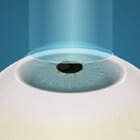Hyperopia or farsightedness is a fairly common vision problem in which near objects appear blurred while distant objects remain clear.
Most babies are born farsighted, so by the first year of life, about 4% of babies have hyperopia. However, as the infant grows older, this defect disappears and vision normalizes.
Once people turn 40, they develop age-related farsightedness or presbyopia. Thus, one has to move the numbers or letters further from the eyes to see them. This age-related change in vision occurs for physiological reasons. The eye muscles and the front lens of the eye lose their former elasticity and reflect a light beam less well. All this leads to presbyopia.
Hyperopia treatment in adults
The most common and affordable hyperopia treatment is wearing glasses or contact lenses.
This treatment is aimed at focusing the light beams on the retina rather than behind it, as is the case with hyperopia.
Glasses. Glasses. This is a simple and safe way to improve the quality of close vision. Many people who never wore glasses before seeking this method of vision correction after 40-45 years of age. It is essential that the variety of spectacle lenses is very large and it is possible to select glasses for both hyperopia and myopia, and even for astigmatism at the same time.
Contact lenses. Lenses are available in a variety of materials and designs, including soft and hard, gas permeable combined with spherical, toric, multifocal varieties. Ask your doctor about the pros and cons of contact lenses and which lenses are best suited for you.
Machine-assisted treatment. This allows improving the quality of vision for hyperopia and relieving eye strain.
Hyperopia in adults can also be treated surgically.
There are three main types of hyperopia surgery:
- Intraocular phakic lens implantation.Intraocular phakic lens implantation. This is a simple procedure in which an eye surgeon inserts a lens inside the eye between the cornea and the crystalline lens. The patient can see perfectly well shortly after the surgery. The advantage of this technique consists in enjoying your usual life and still seeing well without taking or putting the lens on or off. And the key point about this procedure lies in the fact that the natural crystalline lens is preserved in the eye.
- Lens replacement with an intraocular lens.During the surgery, an intraocular lens is placed in the anterior or posterior chamber of the eye. This surgery is often performed for cataract treatment when two issues need to be solved simultaneously: extracting the cataract and getting rid of hyperopia. Multifocal intraocular lenses allow minimizing the use of glasses and getting rid of myopia and hyperopia at the same time.
- Laser vision correction.In the past, laser vision correction was prohibited before 40 years of age. But modern technologies are not standing still. Today, Eximer Ophthalmology Clinic can perform age-related laser vision correction, including hyperopia.
We are the only ones to offer you the exclusive PresbyMax program, which includes two types of laser vision correction:
- PresbyLasik method;
- PresbyFemto using Femto technology.
These laser vision correction techniques affect the cornea of the eye by changing its curvature so that light beams hit the retina instead of behind it. The procedure is quick, safe, and painless thanks to local droplet anesthesia.
All of the above techniques of age-related hyperopia correction are available at Eximer Ophthalmology Clinic in Kyiv and Odesa (Ukraine).
What is the danger of hyperopia?
Any disorder requires timely and competent treatment, and hyperopia is no exception. If treatment with glasses, lenses, or surgery is not begun in time, hyperopia may lead to constant eye strain, excessive lacrimation, strabismus, headaches, difficulty reading, and problems with the hand and eye coordination.
Newborns often have mild hyperopia that resolves on its own as their eyes grow. With mild hyperopia, some children do not notice blurred vision or related signs and symptoms at an early age.
If the condition is more severe, referred to in the medicine as severe hyperopia, then if left untreated, the child is at increased risk of developing other eye disorders such as the lazy eye (amblyopia) or strabismus.
Lack of age-related hyperopia treatment affects a person’s general well-being: there may be eye pain, constant migraines, discomfort in daily life, including difficulty reading, writing, and even shopping at the store.
Symptoms of hyperopia
If you are holding a book ever further away from your eyes so that you can see the letters without squinting or straining, it could be a sign of hyperopia. Even without realizing it, you may make a greater effort to find the perfect distance between your eyes and the object at which you can see well.
Here are the symptoms of hyperopia you may notice:
- Eye strain.
- Headaches from doing work at close distances.
- General eye discomfort.
- Need for more light when reading.
- Blurred vision at normal reading distance.
- Need to hold reading media at arm’s length.
However, mild hyperopia may never cause any noticeable symptoms, which is why, according to the National Eye Institute (USA), it is critical to get your eyesight checked regularly.
Is it possible to cure hyperopia in an adult?
Age-related farsightedness (presbyopia) is part of the natural aging process of the eye. Technically, presbyopia is the loss of the eye’s ability to change focus to see close objects. Presbyopia usually appears in your early 40s and gradually worsens until about 60, when vision usually stabilizes. But there is some good news. If you ask, can farsightedness be corrected? Yes! It can be corrected and treated using the latest technology.
Depending on your general health and lifestyle, the following correction and treatment options for hyperopia can be offered:
- Glasses or contact lenses;
- Machine-assisted treatment;
- Laser vision correction;
- Multifocal intraocular lenses;
- Intraocular phakic lenses.
Before deciding on a treatment method, make sure you have a comprehensive vision test and a consultation with an experienced ophthalmologist. Choose exactly the treatment option that best suits your lifestyle and state of health.
Ways to improve your vision with hyperopia
Unfortunately, it is rather difficult to stop the hyperopia progression. The more so because there is age-related farsightedness as one of the symptoms of aging. But there are some methods that can improve hyperopia and slow down its deterioration with age.
- Proper lighting significantly reduces eye fatigue.
- Annual eye exams. The condition of your eyes can change literally over the year, so make regular visits to a specialized eye care center. Talk to your doctor about any change in symptoms that could be a sign of serious disease.
- Stick to a healthy and balanced diet with lots of green leafy vegetables.
- Do physical exercise.
- Drink enough water to avoid dehydration.
- Limit alcohol consumption.
- Avoid smoking.
- Wear sunglasses. They protect the delicate tissues of your eyes from harmful UV rays.
Correcting hyperopia involves
Multiple vision correction options:
Glasses. No matter whether or not you’ve been wearing glasses due to other vision problems, it may now seem like it’s time to switch to something more comfortable for your eyes.
- Reading glasses. They should only be worn for close work, such as reading.
- Bifocal glasses. They are often prescribed for presbyopia. These are glasses with two different prescriptions in the same eyeglass lens, both for close and far distances.
- Progressive glasses are lenses similar to bifocals, but with a smoother transition between focal points.
- Glasses for computer work.
Contact lenses. There are many contact lenses available to suit your hyperopia.
- Bifocal contact lenses. They allow you to see at close and far distances.
- Multifocal contact lenses. They are similar to bifocal lenses, and these terms are often used synonymously, yet multifocal lenses allow you to see not only at close and far distances but also at a distance of 6-7 meters.
- Contact lenses with Monovision technology. When a lens is used on one eye to work at close range and on the other eye to work at a far distance.
Laser vision correction for hyperopia
Scientific breakthroughs never stand still and have had a particularly powerful impact on ophthalmology. Eximer Ophthalmology Clinic offers you the latest technological methods of laser vision correction. Before 40-45 years of age was an obstacle for laser correction of hyperopia, but now it is definitely not the case anymore.
It is worth mentioning that lasers allow treating up to +4 diopters of hyperopia. At Eximer Ophthalmology Clinic, you will be offered such methods as:
- Laser hyperopia correction using Lasik technique,
- 5D-Eye Lasik,
- Femto Lasik,
- Thin flap technology.
Eximer Ophthalmology Clinic is the only center offering laser correction of age-related farsightedness with the PrebyMAX program, which consists of 3 stages:
- Thorough diagnostics.Here, the vision and the eye condition are checked and the future vision is simulated with multifocal contact lenses.
- Getting ready for surgery.If a patient meets all the parameters for laser vision correction, detailed preparation for surgery is carried out. You must undergo several tests, including COVID-19, and if you wear lenses, you must refuse them for a while.
- Several techniques are used, depending on the medical indications and preferences of the patient.
- PresbyLasik based on the Lasik technique.
- Presby FemtoLasik using a femtosecond laser to form a corneal flap.
Laser correction of age-related farsightedness is characterized by the highest level of expertise in diagnostics and modeling of vision. Laser correction is performed using Schwind Amaris excimer laser. Additionally, special technology of corneal laser resurfacing is used during the surgery.
Hypermetropia surgical treatment
Due to the structure of the eye, high degrees of hyperopia, or other medical conditions, laser vision correction may be contraindicated. In this case, an ophthalmologist can offer a highly effective and safe surgical treatment for hypermetropia, namely:
- Intraocular multifocal lens implantation.This surgery involves extracting the lens, which is no longer able to perform its functions. It is replaced with an intraocular lens, which allows you to see both at close and far distances without glasses. By the way, this surgery is also effective for cataracts. You can immediately get rid of both the disease and age-related farsightedness.
- Phakic lens implantation. In this case, a lens, similar to a contact lens, is implanted inside the cavity between the cornea and the crystalline lens. The key point, the lens is not removed.
Hypermetropia machine-assisted treatment
One of the most effective and proven methods of treating hyperopia, especially in childhood, is physiotherapeutic vision treatment. This is a set of procedures designed to improve vision and increase the “margin of eye safety” in the case of hyperopia.
Machine-assisted treatment of hyperopia in Eximer Ophthalmology Clinic is performed according to a unique methodology developed by our professionals with extensive experience in ophthalmology.
Reasons to undergo machine-assisted treatment at Eximer Ophthalmology Clinic:
- A set of machine-assisted procedures is chosen individually for each patient depending on the findings and other characteristics.
- All procedures are painless and contact-free.
- State-of-the-art equipment that is often unmatched by other specialty clinics.
The network of Eximer Ophthalmology Clinics offers each patient the most advanced services for the diagnosis and treatment of hyperopia.



